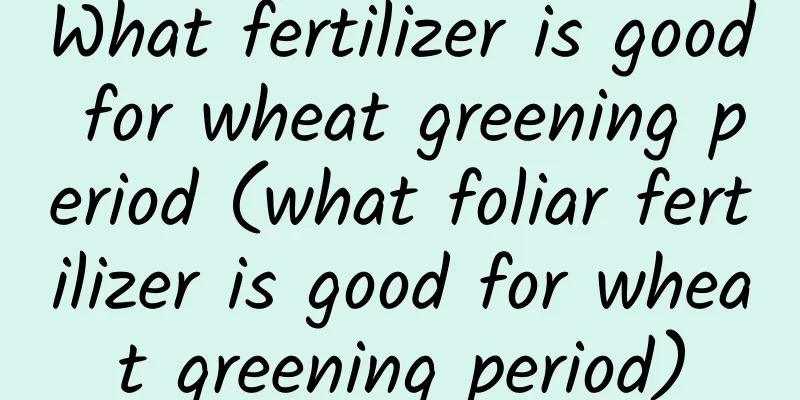What fertilizer is good for wheat greening period (what foliar fertilizer is good for wheat greening period)

|
When wheat reaches the green stage, many farmers often spray some foliar fertilizer to promote growth and increase yield. Top dressing of wheat in early spring is mainly targeted at plots with weak seedlings, including wheat fields that have been damaged by frost after wintering, wheat fields damaged by herbicides, and plots where wheat seedlings have turned yellow due to lack of fertilizer. Are late-sown wheat fields weak seedlings?Late-sown wheat fields must have weak seedlings . Some wheat fields have fewer tillers due to late sowing. As long as management is strengthened after the return to green and a suitable group is formed during the jointing period, high yields can be obtained. If you spray foliar fertilizer after the wheat turns green, it can promote the early greening of wheat . If there is only one leaf before winter, or the plot is covered in soil, you can wait until the jointing stage to use it. What fertilizer is good for wheat greening?Potassium dihydrogen phosphatePotassium dihydrogen phosphate is a phosphorus and potassium fertilizer commonly used by farmers. It can be used in all growth stages of wheat and has a good yield-increasing effect. Spraying during the greening period is beneficial to promoting the greening of wheat. Phosphorus can promote more tillers , and potassium can improve the resistance of wheat seedlings and reduce the occurrence of frost damage and pests and diseases. Spraying potassium dihydrogen phosphate can improve the growth of weak seedlings. During the low temperature period in early spring, wheat seedlings grow slowly and the leaf sheaths at the base of the stems are purple-red. Spraying potassium dihydrogen phosphate can alleviate the symptoms of phosphorus deficiency and promote the growth of wheat seedlings. Amino acid foliar fertilizerSpraying amino acid foliar fertilizer can promote the growth of wheat roots, increase photosynthetic efficiency, and promote leaf growth . For wheat fields with frost damage, spraying amino acid foliar fertilizer can directly promote the absorption of leaves, promote the growth of leaves that are not frozen, reduce the impact of frost damage, and have the effect of promoting weak leaves to become strong. Liquid nitrogen fertilizerIf weak wheat seedlings are to turn green early and become strong seedlings, they need a greater amount of nitrogen to increase tillering . Liquid nitrogen fertilizer is a popular product in recent years. It is directly absorbed by the leaves, and some can even replace the use of green fertilizer. When using liquid nitrogen fertilizer, you should choose a product with quality assurance. Plant Growth RegulationIn the early spring of wheat, the commonly used plant growth regulators are brassinolide and aminoethyl ester, which can promote the growth of wheat seedlings . Especially in wheat fields with frost damage and herbicide damage, spraying can stimulate the growth of wheat seedlings. Moreover, there are frequent cold snaps in spring, and spraying can prevent frost damage. When the temperature is below 10℃, use aminoethyl ester, and when the temperature is higher, use brassinolide. It is recommended to use foliar fertilizers for wheat with regulators to promote nutrient absorption and save labor. For example, potassium dihydrogen phosphate and brassinolide can be used to alleviate frost damage. 80-100 grams of potassium dihydrogen phosphate, 10 milliliters of brassinolide, and 30 kilograms of water can be used per mu. When spraying wheat foliar fertilizer, the temperature should also be considered. It is best to use it above 10°C. Spraying too early will result in low absorption and utilization rate. |
<<: When is the best time to plant red beans (the best time and method to plant red beans)
Recommend
What is water shield?
What is water shield? Water shield is an aquatic ...
Does the golden finger bloom?
Is the golden finger blooming? Golden Finger is a...
How to care for Kalanchoe in winter
Is Kalanchoe afraid of cold? Kalanchoe is not col...
How many days does it take for lettuce to germinate? How many days does it take for lettuce to germinate?
How long does it take for lettuce to germinate? I...
Can soy milk be used as fertilizer?
Soy milk water as fertilizer It takes a certain a...
How to prune potted Buddha belly bamboo
1. Dwarfing treatment Only by dwarfing the plant ...
When to plant shallots?
Scallion is a common seasoning vegetable . It pre...
How to cultivate Artemisia selengensis
1. Soil Artemisia selengensis is suitable for cul...
How to propagate trees and what to pay attention to
Tree propagation method There are four ways of tr...
Cyclamen seedling management
The most important management measure during the ...
How to grow potted pomegranates well
Pomegranate potted cultivation method 1. Water: P...
Rose cultivation methods and precautions
1. Sunlight Rose is a light-loving flower and tre...
What kind of crop is apple? Is it an agricultural crop?
What crop is apple? Apple is a plant of the genus...
The efficacy and function of February orchid
effect Ornamental value Perhaps everyone’s deepes...
Can succulents be exposed to rain? (What to do if succulents grown outdoors are exposed to rain?)
Is it good for succulents to get caught in the ra...









